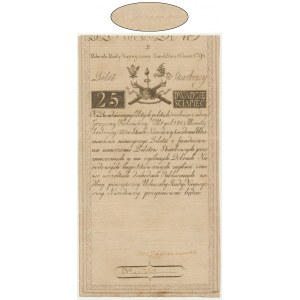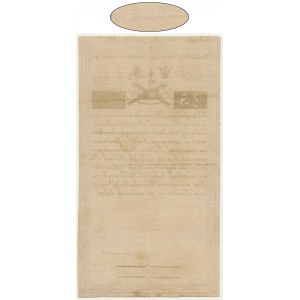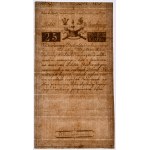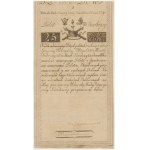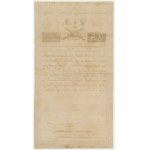Piece printed on paper without additional watermark pieces.
Low serial number. The banknote is printed on thin paper, quite different from the vast majority of known 25 zloty tickets.
Thebanknote's field shows fractures and sagging, but the overall presentation is very correct. The dry stamp is legible.
The banknote is intriguing due to the very unusual signature of Commissioner Grozmani.
Czeslaw Miłczak, in his catalog, on the page devoted to the 25 zloty bill of the 1794 Insurrection, reports that:
"P. Grozmani's signature has been placed secondarily (on a fuzzy background) in the place of the inked signature of another commissioner, whose name is unknown."
Such a hypothesis was first put forward by Lech Kokociński in his article "Banknotes of Polish national uprisings - research postulates" published in Numismatic Bulletin No. 2(294)/1994, writing (p. 9) that
"... it is an absolutely indisputable fact (this was stated by the paper conservation laboratory of the National Library in Warsaw) that the original signature - of an unknown commissioner - on the left side of the banknote on all 25 zloty banknotes was chemically etched! The existing signature of commissioner Piotr Grozmani on these banknotes was put down secondarily, i.e. in place of the previous signature of another commissioner, which had been etched under it. Which one? For what was he deemed unworthy to sign? It is apparent to the naked eye on all known 25 zloty banknotes that Grozmani's signature was placed on a blurred background, that it is always clearer and later than the signature of the other commissioner, Michal Zakrzewski...".
It would seem that the presented 25 zloty bill bearing the low serial number 2056 is unique in this respect, since the signature of P. Grozmani that appears on it was not made on a blurred background and is not clearer or later than the signature of M. Zakrzewski. One could advance the theory that it is clearly a primary signature, not a secondary one, and on the contrary it is faintly visible.
Nevertheless, there is a parallel feeling in the community that the theory of the signature being lured out is far from the facts. In the source documents, we do not find any reports as to the objections to the commissioners raised by the Directorate of Revenue Tickets, or by the RNN.
We sought the opinion of Robert Jadrych, a recognized researcher of Kosciuszko Insurrection tickets, in this regard.
According to Robert Jadrych's findings, in many cases the frame from the stamp with which the security mark was applied has been superimposed on Zakrzewski's signature. This gives the impression of a blurring/bleeding of signatures on some pieces of 25 zloty stamp tickets, where a more aggressive chemistry was used or the frame line coincided with the place where the signature was applied. The process of significance was all the time (during "production") refined and modified hence the variety of its "variations". (On the preserved ridges we can especially observe their variety).
The theory adopted by Robert Jadrych is strongly convincing, as we also see no reason for the commissioner's signature to have been purposely linted. For our part, we would add that the distinctly different signature of Commissioner Grozmani is also the result of the thin paper used to print the pieces presented.
In conclusion, this banknote, brings a new element to the discussion of P. Grozmani's "secondary" signature, the mystery of which still remains to be solved, but regardless of the final findings, we have no doubt that we can confidently consider this piece as extremely interesting and also rare due to the thinner paper used for printing.
In the Polish lands, the introduction of paper money into circulation was connected with expenses related to the outbreak of the Kosciuszko Insurrection. Its issuer was the Directorate of Treasury Tickets established by the Supreme National Council. In terms of value, treasury tickets were equated with coinage. Obligations to the Treasury could be paid a maximum of 50% in paper money and the remainder in coins. This condition resulted in its negative reception by the public. In the future, the redemption of treasury tickets was to be financed from national wealth. For counterfeiting paper money, the death penalty was stipulated, as well as the confiscation of all the perpetrator's property. On September 29, 1794, in order to strengthen confidence in treasury tickets, the National Supreme Council authorized the regulation of the entire amount in paper pennies and zlotys. Due to the failures of the uprising, public confidence in paper money was declining. The population preferred to accept bullion money in settlements. The range of issuance of the first Polish paper money was small - it was introduced on a large scale only in Warsaw. After the capture of the capital on November 6, 1794, tickets of all denominations for a total of 7.8 million Polish zlotys remained in the hands of the population.
On June 8, 1794, the Supreme National Council passed a resolution establishing an issuing institution - the Directorate of Treasury Tickets - and introducing treasury tickets in denominations: 5, 10, 25, 50, 100, 500 and 1000 Polish zlotys. Treasury tickets with an issue date of June 8, 1794 are very similar. They are one-sided printings in the form of a standing rectangle differing only in color and border detail. Each denomination was hand-numbered and signed by two or three representatives of the Treasury Ticket Directorate. In addition, each ticket bears the dry seal of the Treasury Ticket Directorate.
After printing, paper money of equal denomination was stapled together in the form of a cloth-bound "booklet." When they were put into circulation, they were hand-cut from them by which tickets of the same denomination differed in size and in the shape of the top edge. The part that remains in the "booklet" and the coin released into circulation have the same number.
